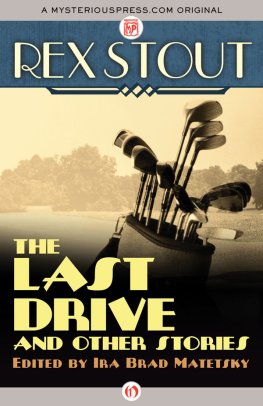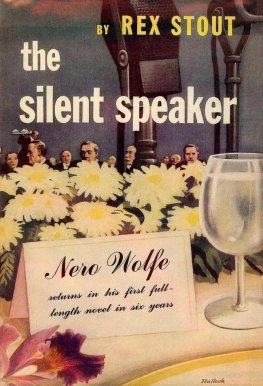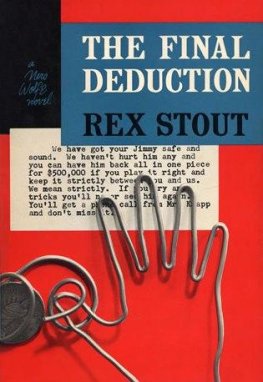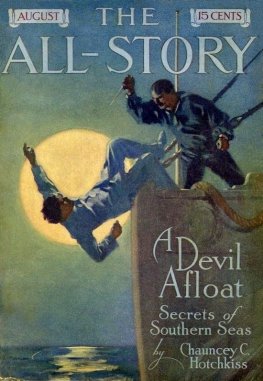Rex Stout
The Last Drive and Other Stories
Today, Rex Todhunter Stout (18861975) is remembered primarily as the creator of Nero Wolfe and Archie Goodwin, who appeared in 72 murder mysteries published between 1934 and 1975. But two decades before he created Nero Wolfe, Rex T. Stout authored at least 46 works of fiction novels, novellas, and short stories spanning a variety of genres. These works appeared in at least ten different magazines between 1912 and 1918.
Stout had travelled from his native Kansas to New York seeking a career as a writer. In 1913, he told the newspaper back home in Topeka that he felt an irresistible attraction to writing, and that he was strongly of the opinion that New York City is the field in America for anyone desiring to enter upon a literary career. Stout hit the ground running, selling fourteen stories to a variety of publishers in his first year, and receiving from $18 to $40 for each. Over the next four years or so, he wrote and sold five novels and two dozen more short stories. And then he stopped writing, having concluded that hed been writing for money rather than for art, and that he needed to make his fortune so as to gain the freedom to write what he wished rather than what publishers would pay for. He stayed away from the typewriter for more than a decade.
Some of Stouts early stories show signs of the literary talents that would later give rise to the Nero Wolfe corpus, and some, frankly, do not. But all of them should be of interest to the many fans and admirers of Stout and his work. During the 1970s, Stouts biographer, John McAleer, sought to locate as many of these stories as possible. It was not an easy task. Though McAleer frequently met with Stout while writing the biography, McAleer told another collector, Judson Sapp, that Stout was no help in locating his early stories because they are too far in the day ago for him. He hasnt seen them or thought about them for almost sixty years.
Instead, McAleer visited and communicated with libraries throughout the country. He was handicapped by the limited number of magazine indexes then available (there were no computerized indexes back then, and the pulps and popular fiction were not included in the Readers Guide or comparable works). Even when magazines containing the stories could be located, some libraries still would not provide copies based on copyright and preservation concerns. The Library of Congress denied McAleer access to the serialization of one early novel until McAleer relayed his request through his brother-in-law Congressman Tip ONeill, majority leader of the U.S. House of Representatives.
Despite these obstacles, Stout collectors and bibliographers did ultimately locate the majority of these early Stout stories. The greatest number of them appeared in a popular pulp magazine, The All-Story, and its successors, All-Story Weekly and All-Story Cavalier Weekly, all published by the Frank B. Munsey Company. Others appeared in somewhat more upscale magazines: Short Stories, The Black Cat, The Smart Set, Lippincotts Monthly Magazine, and Smiths Magazine.
McAleer discussed the stories he had found in several chapters of his magisterial Rex Stout: A Biography, later republished as Rex Stout: A Majestys Life. (On reading McAleers first draft, Stout opined that I think there is too much detail of... the stuff I wrote in my twenties, though he conceded that he was an interested party and I cant safely trust my judgment.) McAleer also published a collection chosen from the early stories, Justice Ends at Home and Other Stories, in which the lead story was Stouts first murder mystery, as well as an edition of Under the Andes, a serialized 1914 novel representing Stouts foray into science fiction. McAleers introductions to the two volumes are required reading for fans of early Stout. Later collectors published two more collections of the early short stories (Target Practice, which reprinted the stories from All-Story, and An Officer and a Lady and Other Stories) and three more early novels (Her Forbidden Knight, A Prize for Princes, and The Great Legend). But no one knew whether all the early works of Rex Stout had yet been found.
Today we know they had not. In this volume, we present eleven more early stories by Rex Stout, all first published between 1912 and 1918. The first story in this volume, The Last Drive, was Stouts second murder mystery novel (after Justice Ends at Home), published in a completely unexpected place, Golfers Magazine. Its rediscovery is the most important development in Stout scholarship in the past twenty-five years. The other stories include a supernaturalistic shaggy-dog story (Ask the Egyptians), an ironic tale of local politics (The Pickled Picnic), several pulp romance tales, and at least one romance-that-wasnt (to say here which story would spoil it). Although the stories are a century old, all stand up to modern reading.
For the rediscovery of eight of the stories in this volume, we are indebted to the volunteer indexers of the comprehensive and ongoing FictionMags/Galactic Central magazine indexing project (www.philsp.com) under the leadership of Phil Stephensen-Payne and William G. Contento, as well as the editors of Rex Stouts bibliography on Wikipedia, whose addition of these new stories first drew them to my attention. For finding and recognizing the significance of The Last Drive, we are grateful to Ross E. Davies and Cattleya Concepcion of The Green Bag Almanac and Reader (www.greenbag.org). For encouraging my work on this volume, I thank Rex Stouts daughter, Rebecca Stout Bradbury; Otto Penzler and Rob W. Hart of The Mysterious Press; the staff of the Burns Library at Boston College, archival repository of the Rex Stout, John McAleer, and Judson Sapp papers; Noah Peters, who located copies of many of the stories at the Library of Congress; and of course my colleagues and friends of the Wolfe Pack, the worldwide literary appreciation society for the many fans of Rex Stout (www.nerowolfe.org).
Despite substantial research efforts to locate all the remaining early works of Rex Stout, of course we may still have missed some. Please bring any new discoveries or leads to our attention at werowance@nerowolfe.org.
Ira Brad Matetsky
The Last Drive
Introduction
The Last Drive is a detective fiction novel a murder mystery that was serialized in Golfers Magazine in six installments from July to December 1916. Golfers Magazine primarily consisted of non-fiction for golfing enthusiasts, but some issues included a piece of golf-related fiction.
Rex Stout was never known as a golfing enthusiast, and the fact that he published fiction in Golfers Magazine was entirely unsuspected until 2011, when researcher Cattleya Concepcion came across a citation to this story in a Copyright Office register while searching under Stouts name for something else. (It is fortuitous that the story was listed under Stouts name; everything Stout published in other magazines during this period was copyrighted in the magazine owners names, not Stouts.)
Stouts earlier novella Justice Ends at Home and The Last Drive are the two main pieces from Stouts early writing career from which one might have extrapolated important elements of the early Nero Wolfe books written twenty years later. But to say more of The Last Drive would spoil the story, so let us hold our thoughts for the afterword.

















